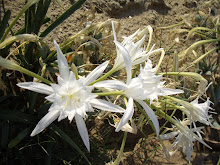Love-in-a-Mist
| Blue flower of love-in-a-mist. |
| |
| Love-in-a-mist is a charming, old-fashioned annual flower. |
Love-in-a-mist, Nigella damascena, is a charming old-fashioned flower that blooms in spring and early summer. The genus name Nigella comes from the Latin niger (black), referring to the intense black seeds. One of about 15 species in this genus in the buttercup family (Ranunculaceae), N. damascena comes from southern European and northern Africa. In its native habitat it grows in fields, along roadsides, and in rocky or waste ground.
This small to medium sized annual grows 15-24" high and up to a foot wide (if not crowded). Plants have finely cut, bright green leaves that resembles fennel leaves. Light green, lacy, finely divided threadlike bracts form the “mist” surrounding the jewel-like flowers.
| |
| The finely divided, green bracts form the "mist" surrounding the flowers. |
Flowers are usually bright blue to very pale blue, but some may be white, pink, or lavender. Each flower is 1½” across, with 5 large, petal-like sepals and small, deeply divided petals hidden beneath the stamens. The flower is followed by attractive, balloon-shaped “seedpod” (actually an inflated capsule composed of 5 fused true seedpods) up to 2” long and green with purple or bronze stripes. Love-in-a-mist looks good in the garden even when the plant is not in bloom, with its handsome foliage and interesting seedpods after flowering.
| |
| Love-in-a-mist is good addition to the informal garden. |
N. damascena works well mixed with other annuals in the informal or cottage garden. It is good for filling gaps in the flower border and for short-term massed bedding. Individual plants can be added to hanging baskets, window boxes or containers where the finely-cut foliage provides nice contrast until the plants begin blooming. Love-in-a-mist could be used for edging, as a mass planting or in combination with silver-leaved plants such as dusty miller or lamb’s ear. You could even create an everlasting garden by planting them with strawflowers, bachelor buttons, bells of Ireland, globe amaranth or other flowers for drying.
| |
| A white-flowered double form. |
Love-in-a-mist is very easy to grow. The plants do best in full sun in well drained, fertile soil. Sow the deep black, sharp-cornered seed about ⅛” deep where you want the plants to grow, as love-in-a-mist does not transplant well because of the plant's long taproot. Seeds should germinate within 2-3 weeks under most conditions. Begin sowing as soon as the soil can be worked in early spring. Seeds can be started indoors 4-6 weeks before transplanting outdoors, but they should be sown in individual peat pots and transplanted with care. Love-in-a-mist tolerates frost, so is primarily a spring and fall annual; it does not perform well in hot weather.
| |
| Love-in-a-mist has a short bloom period. |
N. damascena has a short bloom period (only a month or two). Make successive plantings every three weeks for continuous bloom all summer. Thin the seedlings to 8-10” between plants when large enough to handle. The plants should begin blooming about three months after planting. Deadheading will prolong flowering (but will eliminate seedpods). Spring-seeding often produces smaller plants with smaller flowers. In many areas, summer or fall sowing will produce seedlings that overwinter to grow earlier and larger the following spring (but then are spent earlier in the season).
Once established, love-in-a-mist readily self-sows. Thin the seedlings while small, if desired, to prevent overcrowding or encroachment on neighboring plants. Deadhead regularly or remove seedpods early to reduce the density of volunteer seedlings. The aromatic seeds have been used, particularly in Turkey, the Middle East and India, for culinary and medicinal purposes, although this species is inferior to N. sativa (black cumin) whose seeds develop a slightly bitter, oregano-like flavor and aroma when ground or chewed.
| |
| The seedpods dry well. |
The cultivars have larger flowers, often with extra rows of sepals (double flowers), and come in a wider range of colors than the species, which is typically just blue. Some cultivars include:
- 'Miss Jekyll' – has soft blue, semi-double flowers. This variety is the result of many years of careful selection and is the most commonly offered cultivar.
- 'Miss Jekyll Alba' – a pure white semi-double selection.
- 'Mulberry Rose' – a deeper pink selection.
- 'Oxford Blue' – a tall variety with dark seed pods and deep blue flowers.
- 'Persian Jewels' series – is a mixture of shades of mauve, lavender, purple, rose, light blue and white double flowers.
Both the flowers and the decorative green and burgundy seed pods can be used in fresh or dried floral arrangements. Cut flowers last longer if the leaves are removed from the lower part of the stem. To dry the seed pods, harvest when the stripes are still visible and hang pods upside down in a dry, dark, airy place. You may want to place them in paper bag to contain the seeds. Dividing the pods into small batches in separate bags will facilitate more rapid drying than placing them all in one large bag.
Go to page: http://www.hort.wisc.edu/mastergardener/features/flowers/nigella/nigella.htm
Για το χατίρι τής Αστοριανής (Γιώτα Στρατή)


Δεν υπάρχουν σχόλια:
Δημοσίευση σχολίου